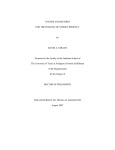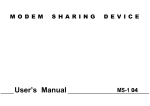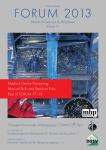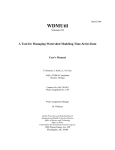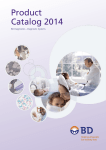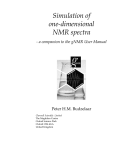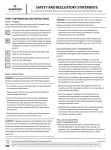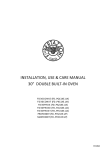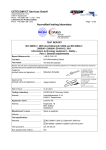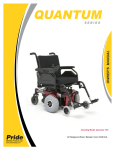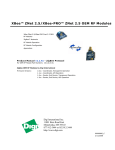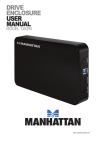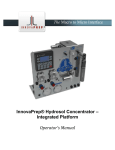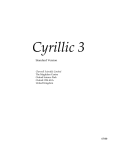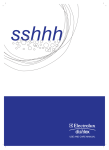Download AUTOCLAVE - Codice n
Transcript
“SAS SUPER 100/180”, “SAS ISOLATOR”, “DUO SAS 360”, “DUO SAS ISOLATOR” INSTRUCTIONS MANUAL Carefully read this Manual before operating your instrument. This document is the property of VWR International PBI srl Milan It may not be duplicated or distributed without the owner’s authorisation REFERENCES FDA – 1987 Guideline on Sterile Drug Products produced by Aseptic Process ACGIH – Guideline for the Assessment of Bioaerosol in the Indoor Environment ASTM – Draft Protocol – Committee D22.05.06 USP 23-NF 18 8th Supplement 1116 (May 1998) – Microbiological Evaluation of Clean Rooms and other Controlled Environments EU Guide for GMP – Manufacture of Sterile Medicinal Products Control of Medicines and Inspection CEN/TC 243 Norms for Clean Room Technology For any further information please contact: United States United Kingdom 11333 Woodglen Drive Rockville MD 20852 Telephone 7& 8 Launton Business Centre Murdock Road Bicester OX26 4XB Telephone: +44 (0) 1869 355 500 Fax: +44 (0) 1869 355 545 E-mail: sales@cherwell-labs.co.uk Telephone: 301-231-7400 Fax: 301-231-7277 E-mail: BioInfo@Biosci-Intl.com Rev.9 September 2012 User Manual – SAS Super 100/180 – SAS Super Isolator 100/180 – DUO SAS 360 - DUO SAS 360 Isolator INSTRUCTIONS MANUAL READ CAREFULLY THIS HANDBOOK SAFETY INSTRUCTIONS • Use the device just for the indicated purposes. • The Device must be correctly used according to this instructions manual, before starting any operation. • Replace immediately any electrical cable when damaged; never use a damaged or worn electrical cable. • Always disconnect the charger before: A. Repairing or maintenance; these operations must be carried out by qualified staff; B. Keep the unit clean; • Use original spare parts and accessories for any replacement; • Do not use this device in the presence of explosive gas. GENERAL CAUTION Be aware that the voltage and frequence of the electrical system are compatible with the electrical requirements of the battery charger. CAUTION Never use a non-OEM charger to charge the air sampler. Use of improper charger may damaged the unit CAUTION Rev. 9 Pg. 2 User Manual – SAS Super 100/180 – SAS Super Isolator 100/180 – DUO SAS 360 - DUO SAS 360 Isolator SUMMARY Main Index SUMMARY.......................................................................................................................................................3 SECTION 1 - BRIEF INSTRUCTIONS...........................................................................................................5 1.1. Brief instructions for SAS Super 100 / 180 and SAS Isolator ............................................................5 1.2. Brief operating instructions for DUO SAS Super 360 - DUO SAS Isolator.......................................5 SECTION 2 - INTRODUCTION......................................................................................................................6 2.1. Principle of Surface Air System...........................................................................................................6 2.2. The basic idea.......................................................................................................................................6 2.3. The practical use of contact plates.......................................................................................................7 2.4. SAS models available..........................................................................................................................7 SECTION 3 - FIRST OPERATIONS................................................................................................................9 3.1. Preliminary inspection.........................................................................................................................9 3.2. “55 mm Contact Plates” Holder Adjustment.....................................................................................10 3.3. “84 mm Maxi-Contact Plates”..........................................................................................................10 3.4. Volume of agar in each plate..............................................................................................................10 3.5. Tripod installation (optional)..............................................................................................................11 3.6. List of menu and utility sub-menu.....................................................................................................11 SECTION 4 - OPERATIONS AND MENUS..................................................................................................12 4.1. Operations..........................................................................................................................................12 4.2. Start with the same air volume as the previous sample ....................................................................12 4.3. “Standard mode” function..................................................................................................................13 4.4. “User mode” function........................................................................................................................13 4.5. “Program mode” function..................................................................................................................14 4.6. “Delay mode” function......................................................................................................................15 4.7. “Multimode” function........................................................................................................................15 4.7.1. Start a multimode sampling cycle............................................................................................16 4.8. “Utility mode” function......................................................................................................................17 4.8.1. “Set time”.................................................................................................................................17 4.8.2. “Mode”.....................................................................................................................................17 4.8.3. “Set autoswitch”.......................................................................................................................18 4.8.4. “Print”......................................................................................................................................18 4.8.5. “Display record”......................................................................................................................18 4.8.6. “Clear record”..........................................................................................................................19 4.8.7. “Language”..............................................................................................................................19 4.8.8. “Identify”.................................................................................................................................19 4.8.9. “Sampling Site”........................................................................................................................20 4.8.10. “Calibration due” OPTIONAL FEATURE............................................................................20 4.9. List of all system message..................................................................................................................21 4.10. Accessories.......................................................................................................................................21 4.10.1. Battery charger.......................................................................................................................21 4.10.2. Remote control.......................................................................................................................22 4.10.3. SAS Software.........................................................................................................................22 4.10.4. SAS Printer............................................................................................................................22 SECTION 5 – MAINTENANCE.....................................................................................................................23 5.1. Air Sampler Disinfection....................................................................................................................23 5.2. Validation and Calibration..................................................................................................................23 5.3. Performance routine monitoring........................................................................................................24 5.4. Battery replacement...........................................................................................................................24 5.5. Troubleshooting..................................................................................................................................25 Rev. 9 Pg. 3 User Manual – SAS Super 100/180 – SAS Super Isolator 100/180 – DUO SAS 360 - DUO SAS 360 Isolator SECTION 6 – SAMPLING PROCEDURE.....................................................................................................26 6.1. Contact Plate handling.......................................................................................................................26 6.2. Use of the air sampler in Clean Areas................................................................................................26 6.3. Contact Plates preparation..................................................................................................................27 6.4. Adjustable “Contact Plate” holders....................................................................................................27 6.5. Sampling time required for different air volumes..............................................................................27 6.5. Total Bacterial Count and/or micro-organisms identification by dilution.........................................28 6.6. Multi Point Sampling with several independent air samplers............................................................28 6.7. Final operations..................................................................................................................................29 6.8. Calculation of results..........................................................................................................................29 6.8.1. Colony Forming Units per 1000 litres of air............................................................................29 6.9. Data recording....................................................................................................................................32 SECTION 7 - SPECIFICATIONS...................................................................................................................33 7.1. Specifications.....................................................................................................................................33 7.2. SAS Components Description ...........................................................................................................34 7.3. Automatic switch off.........................................................................................................................35 SECTION 8 - ACCESSORIES........................................................................................................................36 8.2. SAS Model.........................................................................................................................................36 8.2. Accessories and spare part list............................................................................................................36 8.2. Control and Validation Systems.........................................................................................................36 SECTION 9 – IDENTIFICATION SHEET.....................................................................................................37 SECTION 10 – SAS ISOLATOR....................................................................................................................38 Rev. 9 Pg. 4 User Manual – SAS Super 100/180 – SAS Super Isolator 100/180 – DUO SAS 360 - DUO SAS 360 Isolator SECTION 1 - BRIEF INSTRUCTIONS 1.1. Brief instructions for SAS Super 100 / 180 and SAS Isolator The air flow is displayed after the automatic presentation every time the instrument is switched on. Press ON/OFF switch. Press START button to sample the same air volume of the last sampling cycle. To change the air volume, use the arrow buttons and select “Standard Mode” from menu. Refer to the instruction manual to change settings. Press ENTER to confirm selection. Press arrows for menu selection to modify other pre-set parameters: STANDARD MODE USER MODE PROGRAM MODE DELAY MODE MULTI MODE UTILITY MODE Press ENTER to reach the sub-menu of the chosen parameter. Refer to instruction manual to change settings. Press ON/OFF switch at the end of sampling operations. Press “CLEAR” each time you need to end an action. Then the unit will come back to the initial configuration. 1.2. Brief operating instructions for DUO SAS Super 360 - DUO SAS Isolator Press the ON/OFF switch (black button). When the display will show the message SELECT HEAD, press ENTER. Press “UP” or “Down” arrows to select the “LEFT HEAD” or the “RIGHT HEAD” or “LEFT+RIGHT HEAD”. Press ENTER to confirm selection. Press START button to sample the same air volume as the last sampling time. To change the volume of air or other parameters, follow the given instructions for SAS Super 100 and SAS Super 180. Rev. 9 Pg. 5 User Manual – SAS Super 100/180 – SAS Super Isolator 100/180 – DUO SAS 360 - DUO SAS 360 Isolator SECTION 2 - INTRODUCTION 2.1. Principle of Surface Air System The Surface Air System (SAS) encompasses several models which use the same principle. Air is aspirated at a fixed speed for variable time through a head which has been machined with a series of small holes of a special design. The resulting laminar air flow is directed onto the agar surface of a “RODAC Plate” (or a Petri dish) containing medium for the microbiological analysis. When the selected sampling cycle is completed, the plate is removed and incubated. The organisms are then visible to the naked eye and can be counted for the assessment of the contamination level. 2.2. The basic idea The key features of the Surface Air System (SAS) are: A. To use a simple and inexpensive “Contact Plate” (“SURFAIR PLATE”, “RODAC”) for surface, hands or air control. These plates are very well known and easily available. They can be purchased ready poured with different media. B. To sample a known volume of air for a variable time to provide a range of sampling volumes. C. To aspirate air in a laminar flow pattern with sufficient velocity to impact organisms onto an agar surface. D. To accumulate data on the level of hygiene in each environment so that fluctuation can be monitored. E. To take advantage of advanced electronics for more reliable results in different operating conditions. F. To have the flexibility to choose between 55 mm Contact Plates, 84 mm Maxi Contact Plates or 90 mm Standard Petri Dishes. G. To apply cGLP and cGMP to air sampling operations. H. To organize sequential sampling to obtain a more representative sample under actual operating conditions. Rev. 9 Pg. 6 User Manual – SAS Super 100/180 – SAS Super Isolator 100/180 – DUO SAS 360 - DUO SAS 360 Isolator 2.3. The practical use of contact plates THE PRACTICAL USE OF “CONTACT PLATES” FOR AIR CONTROL SAS SUPER FLOW SCHEME 1. 2. 3. 4. 5. 6. 7. 8. Remove the aspirating head. Insert an identified, closed and prepared Contact Plate and remove plate lid. Place the aspirating head back onto the sampler. Select the required air volume and start the unit. The air flow is directed onto the agar surface of the Contact Plate. At the end of the cycle, remove the aspirating head. Close and remove the Contact Plate. Incubate the Contact Plate Count the colonies, record the results on the microbiological air sampling report and analyse the results. 2.4. SAS models available 2.4.1. SAS SUPER 100 and SAS SUPER 180: Two instruments for two different applications. The two air samplers have the same performances; the only difference between them is the airflow aspiration rate: SAS SUPER 100 = 100 litres of air per minute SAS SUPER 180 = 180 litres of air per minute. The SAS SUPER 180 is appropriate for use in Clean Rooms and other applications demanding low sampling times. In Clean Rooms, for example, it is important to test a larger volumes of air, because the microbial air contamination is very low. The SAS SUPER 180 reduces the required time to obtain a sample with an important saving of time. Both SAS SUPER 100 and SAS SUPER 180 are identified by the “SAS SUPER” logo on the right side of the instrument. The SAS SUPER 180 air sampler is recognizable by the SAS SUPER 180 logo that appears on the display when the operator turns on the unit. Rev. 9 Pg. 7 User Manual – SAS Super 100/180 – SAS Super Isolator 100/180 – DUO SAS 360 - DUO SAS 360 Isolator 2.4.2. DUO SAS SUPER 360: The instrument is based on the SAS Super 100/180 model, but it includes two heads that can work alone or together 2.4.3. SAS ISOLATOR Critical air monitoring in isolator and barrier environments It consists of a programmable unit which remains outside the controlled area and an independent sampling head which uses RODAC Contact Plates or Standard 90 mm Petri dishes. See Section 10. 2.4.4. DUO SAS SUPER 360: The instrument is based on the SAS Super Isolator model, but it includes two heads that can work alone or together Rev. 9 Pg. 8 User Manual – SAS Super 100/180 – SAS Super Isolator 100/180 – DUO SAS 360 - DUO SAS 360 Isolator SECTION 3 - FIRST OPERATIONS 3.1. PRELIMINARY INSPECTION The apparatus is subject to specific quality tests before shipment and it is carefully packed to avoid possible damage during transit. However, a visible check should be carried out as soon as possible to determine any transit damage. This must be reported immediately. The following procedures should be followed to check that the unit is working properly. The battery pack of the instrument must be charged for at least 14 hours before running the test. SAS SUPER 100, SAS SUPER 180 AND SAS ISOLATOR After the ON/OFF button is pressed an automatic visual presentation will be displayed. In the following displays, the characters “XX” indicates numerical figures. INTERNATIONAL PBI S/N 10-D-XXXX Rev. 5.XX-XXXX PRESS ARROW FOR NEW MENU SELECT * S.SAS 100 L. * ID 0000 SITE AAAA START FOR XXX MM/DD/YY - HH:MM Push the START button to start a sampling cycle with the displayed volume of air. [ XX] → XXX MM/DD/YY - HH:MM The motor will run until the figures in brackets reach the same figure displayed to the right and then it will stop. During the sampling the two red leds are flashing (see position 9 and 20 in the picture of section 7) . Rev. 9 Pg. 9 User Manual – SAS Super 100/180 – SAS Super Isolator 100/180 – DUO SAS 360 - DUO SAS 360 Isolator DUO SAS Super 360 - DUO SAS Isolator After the ON/OFF button is pressed, an automatic visual presentation appears. In the following display, the entry of “XX” indicates numerical figures. INTERNATIONAL PBI S/N 10-D-XXXX Rev. 5.XX-XXXX PRESS ARROW FOR NEW MENU SELECT * DUOSAS 360 L. * SELECT HEAD Select the desires head by “UP” or “DOWN” arrows and press ENTER Push the START button to start a sampling cycle with the displayed volume of air. [ XX] → XXX MM/DD/YY - HH:MM The motor will run until the figures in brackets reach the same figure as displayed to the right and then it will stop. During the sampling the two red leds are flashing (see position 9 and 20 in the pictures in Section 7). 3.2. “55 mm CONTACT PLATES” HOLDER ADJUSTMENT The Contact Plate holders can be adjusted (using an allen screw) in case the available plates slightly different in diameter from the standard 55 mm Contact Plate (see the figure in the Chapter 6.4). 3.3. “84 mm MAXI-CONTACT PLATES” If high fungal contamination is expected in the sampled air, Maxi-Contact Plates are suggested. This is because moulds tend to spread and consequently make counting difficult after incubation. The “84 mm Maxi-Contact Plates” are inserted into the SAS SUPER 100 or SAS SUPER 180 using a special adaptor (Cat.n. 19123). For more details see Application Note N. 89. 3.4. Volume of agar in each plate For a correct sampling efficiency, it is important to respect the plate agar medium volume as recommended by the air sampler supplier (e.g. 16-18 ml of agar medium in 55mm contact plate) to obtain the correct impact of air on the agar surface. Rev. 9 Pg. 10 User Manual – SAS Super 100/180 – SAS Super Isolator 100/180 – DUO SAS 360 - DUO SAS 360 Isolator 3.5. Tripod installation (optional) The SAS can be fixed to a table tripod or a floor tripod. The threaded connection is located under the unit, between the two front feet. When not in use, the screw is protected by a threaded plug. 3.6. List of menu and utility sub-menu MENU DESCRIPTION START FOR XXX This message indicates the air sampler is ready to sample the volume shown STANDARD MODE With this function the air sampler can be set to select one of 8 fixed standard sampling volumes USER MODE With this function the air sampler can be set to select one of 8 programmable sampling volumes PROGRAM MODE With this function you can to modify the 8 programmable sampling volumes DELAY MODE With this function the air sampler can be set to start after a programmable delay MULTI MODE With this function the air sampler can be programmed to extend the total sampling time using “sequential interval time” sampling UTILITY MODE This function led to the following Sub-Menu: SET TIME To adjust date and time SAMPLING SITE To identify the sampling point IDENTIFY To identify the operator’s name LANGUAGE To display text in different languages CLEAR RECORD To clear the recorded sampling data MENU' DESCRIPTION DISPLAY RECORD To show the recorded sampling data PRINT To export the recorded sampling data AUTO SWITCH OFF To disconnect the automatic switch off when the “Infrared Remote” is used MODE To select the aspiration mode between single and multiple CALIBRATION DUE To check the calibration due date Rev. 9 Pg. 11 User Manual – SAS Super 100/180 – SAS Super Isolator 100/180 – DUO SAS 360 - DUO SAS 360 Isolator SECTION 4 - OPERATIONS AND MENUS 4.1. Operations Push the Main switch (black button) to switch on the unit. The Main switch (black button) must be pushed twice to switch on the unit if the automatic switch off timer operated when last used. Press “CLEAR” at any time to return to the initial “START FOR” main screen. The air sampler is provided with eight fixed air volumes (“Standard Mode”) stored in the memory and eight programmable air volumes (“User Mode”) selectable by the operator. The selection of the volume is made by pressing the “▲” or “▼” buttons when the program is in the relevant sub-menu. The following volumes of air are suggested: - Contaminated areas (communities, processing rooms, etc.) 10-200 litres of air - Normal areas (laboratory benches, houses, etc.) 200-500 litres of air - Sterile or high risk areas (clean rooms, operating theatres, etc.) 500-1000 litres of air. 4.2. Start with the same air volume as the previous sample SAS SUPER 100, SAS SUPER 180 & SAS ISOLATOR Switch on the SAS with the black on/off switch, after the initial presentation the main screen will be displayed START FOR XXX MM/DD/YY - HH:MM Push the START button to start a sampling cycle with the displayed volume of air. [ XX] → XXX MM/DD/YY - HH:MM DUO SAS SUPER 360 - DUO SAS Isolator Switch on the SAS with the black on/off switch, after the initial presentation the head selection screen will be displayed SELECT HEAD Select the desires head by “▲” or “▼” arrows and press ENTER, the main screen will be displayed START FOR XXX MM/DD/YY - HH:MM Rev. 9 Pg. 12 User Manual – SAS Super 100/180 – SAS Super Isolator 100/180 – DUO SAS 360 - DUO SAS 360 Isolator Push the START button to start a sampling cycle with the displayed volume of air. [ XX] → XXX MM/DD/YY - HH:MM 4.3. “Standard mode” function The Standard mode function allows the operator to select a sampling volume from a list of eight standard volumes. Switch on the instrument and wait until the main screen is displayed: START FOR XXX MM/DD/YY - HH:MM Press the “▼” or “▲” button to reach the STANDARD MODE MM/DD/YY - HH:MM Press the “ENTER” button, now you can scroll the eight sampling volume. The selectable volumes are 10, 20, 30, 50, 100, 200, 500, 1000 liters). S.PROG XXXX MM/DD/YY - HH:MM Once the desired sampling volume has been reached press the “ENTER” button to confirm. The instrument is now ready to sample the selected volume of air. Press the “START” button to begin the sampling cycle START FOR XXX MM/DD/YY - HH:MM 4.4. “User mode” function If the operator wish to use volumes other than the standards volumes, up to 8 additional volumes can be programmed into the unit. The user-selectable volumes can be selected form the User Mode, while the selectable volumes can be modified using the Program mode function describe in the next paragraph Switch on the instrument and wait until the main screen is displayed: START FOR XXX MM/DD/YY - HH:MM Press the “▼” or “▲” button to reach the USER MODE MM/DD/YY - HH:MM Press the “ENTER” button, now you can scroll the eight sampling volumes user-defined. Rev. 9 Pg. 13 User Manual – SAS Super 100/180 – SAS Super Isolator 100/180 – DUO SAS 360 - DUO SAS 360 Isolator S.PROG XXXX MM/DD/YY - HH:MM Once the desired sampling volume has been reached press the “ENTER” button to confirm. The instrument is now ready to sample the selected volume of air. Press the “START” button to begin the sampling cycle START FOR XXX MM/DD/YY - HH:MM The total number of available “USER MODE” programs is eight. The maximum volume of air for each sampling cycle is 1999 litres. 4.5. “Program mode” function Using this procedure, it is possible to memorise up to eight different volumes (from 1 to 1999 litres of air). (See chapter 4.4.). Switch on the instrument and wait until the main screen is displayed: START FOR XXX MM/DD/YY - HH:MM Press the “▼” or “▲” button to reach the PROGRAM MODE MM/DD/YY - HH:MM Press the “ENTER” button, now you can scroll the eight user-selectable sampling volumes. S.PROG XXXX MM/DD/YY - HH:MM Once the sampling volume to be modified has been reached, press the “ENTER” button to confirm. The display will show the old volume and the new volume. XXX → 0000 MM/DD/YY - HH:MM Press the “▼” or “▲” button to select the first digit and press “ENTER” to confirm XXX → X000 MM/DD/YY - HH:MM Press the “▼” or “▲” button to select the second digit and press “ENTER” to confirm Repeat the previous step until the last digit, when the last digit is confirmed, the new volume will be memorized and added to the list of eight user-selectable volume. If you want to start a sampling cycle with the new value you have to enter the User mode and select it by using the procedure described in paragraph 4.3 Rev. 9 Pg. 14 User Manual – SAS Super 100/180 – SAS Super Isolator 100/180 – DUO SAS 360 - DUO SAS 360 Isolator 4.6. “Delay mode” function With this function it is possible to delay the beginning of the sampling cycle. If a delay has been selected, the sampling cycle will begin after the selected delay time. Switch on the instrument and wait until the main screen is displayed: START FOR XXX MM/DD/YY - HH:MM Press the “▼” or “▲” button to reach the DELAY MODE MM/DD/YY - HH:MM Press the “ENTER” button, the delay time is displayed DELAY 01 MIN MM/DD/YY - HH:MM Select the desired delay time with the “▼” or “▲” button. The selectable delay values are 1, 2, 3, 5, 10 or 20 minutes. Press “ENTER” button to confirm. When a delay has been selected, after the “START” button has been pressed, a delay warning message will be displayed ** D E L A Y ** 4.7. “Multimode” function This program is very useful for extending the time of sampling with the purpose of obtaining a more representative environmental sample “in actual operating conditions”. The total air volume to be sampled is aspirated with two or more sub-volume aspirations (E.g.:1000 litres in ten runs of 100 litres at five minute intervals). Before entering the MULTI MODE you should therefore decide: (a) total volume of air to be sampled onto the Contact Plate; (b) number of runs; (c) interval time between runs. See Application Note N.95 for more details. Switch on the instrument and wait until the main screen is displayed: START FOR XXX MM/DD/YY - HH:MM Press the “▼” or “▲” button to reach the MULTI MODE MM/DD/YY - HH:MM Press the “ENTER” button, the interval time is displayed Rev. 9 Pg. 15 User Manual – SAS Super 100/180 – SAS Super Isolator 100/180 – DUO SAS 360 - DUO SAS 360 Isolator INTERVAL TIME 05 MIN Select the desired interval time between runs with the “▼” or “▲” button. The selectable interval values are 5, 10, 15, 20, 25, 30, or 60 minutes. Press “ENTER” button to confirm the interval time, the numbers of runs is displayed NUMBER OF RUNS 20 NC Select the desired number of cycles with the “▼” or “▲” button. The selectable values are 2, 3, 4, 5, 6, 7, 8, 9, 10, 15 or 20 runs. Press “ENTER” button to confirm the number of runs, the single run volume is displayed SINGLE RUN VOL. XXXX Select the desired digit with the “▼” or “▲” button then press the “ENTER” button to skip to next digit. When all the digits have been selected the total volume is displayed TOT. L. XXXX Press “ENTER” button to confirm. NOTE: Before running the multimode sampling, set the aspirating mode to MULTIMODE (see paragraph 4.8.2) 4.7.1. Start a multimode sampling cycle Before running the multimode sampling, set the aspirating mode to MULTIMODE (see chapter 4.8.2) . When the sampler aspiration mode is set to MULTIMODE, the main display will show alternately the number of cycles and the volume of each cycle: START FOR MM/DD/YY - HH:MM NC 02x1000 L. MM/DD/YY - HH:MM Press the “START” button to run the multiple sampling, the display will show the aspirating volume in the first row and the residual number of the cycle in the second row: [ XX] → XXX - 02 CYCLES At the end of the run, during the interval, the number of “residual cycles” (runs) that are remaining are shown on the display: - 02 CYCLES ** D E L A Y ** Rev. 9 Pg. 16 User Manual – SAS Super 100/180 – SAS Super Isolator 100/180 – DUO SAS 360 - DUO SAS 360 Isolator 4.8. “Utility mode” function With this function it is possible to modify all the settings of the air sampler. The UTILITY MODE is divided into ten sub-menus: Set time; Mode; Set Autoswitch; Print; Display Record; Clear Record; Language; Identify; Sampling site; Calibration due. Always start from UTILITY MODE to reach one of these SUB-MENU. Switch on the instrument and wait until the main screen is displayed: START FOR XXX MM/DD/YY - HH:MM Press the “▼” or “▲” button to reach the UTILITY MODE MM/DD/YY - HH:MM Press the “ENTER” button, the first sub-menu is listed: 4.8.1. “Set time” From the UTILITY MODE select the “SET TIME” function This option is used to program day, month, year and time of the day. SET TIME MM/DD/YY - HH:MM Press ENTER and “▲” or “▼” button to change Press ENTER and “▲” or “▼” button to change Press ENTER and “▲” or “▼” button to change Press ENTER and “▲” or “▼” button to change Press ENTER and “▲” or “▼” button to change Press ENTER to confirm and exit month day year hours minutes 4.8.2. “Mode” From the UTILITY MODE select the “MODE” function This option is used to select the aspirating mode between the SINGLE MODE and MULTIMODE MODE MM/DD/YY - HH:MM Press ENTER and “▲” or “▼” button to change between SINGLE MODE and MULTIMODE MULTI MODE MM/DD/YY - HH:MM SINGLE MODE MM/DD/YY - HH:MM Select the desired aspirating mode and press ENTER to confirm and exit. This setting will be stored in memory even after the instrument is switched off. Rev. 9 Pg. 17 User Manual – SAS Super 100/180 – SAS Super Isolator 100/180 – DUO SAS 360 - DUO SAS 360 Isolator 4.8.3. “Set autoswitch” To save battery consumption the SAS automatically switches off after 4 minutes. The Set autoswitch option is used to enable or disable the automatic switch off. From the UTILITY MODE select the “SET AUTOSWITCH” function SET AUTOSWITCH MM/DD/YY - HH:MM Press ENTER and “▲” or “▼” button to change between the two options AUTOSWITCH ON MM/DD/YY - HH:MM AUTOSWITCH OFF MM/DD/YY - HH:MM Select the desired options and press ENTER to confirm and exit. This setting will be lost after the instrument is switched off. 4.8.4. “Print” The SAS can be connected with a RS232 cable to the SAS printer (cod. 89960) or to a Personal Computer with the SAS Software (cod. 89996). This function is used to start the data transfer form the SAS to the external device. From the UTILITY MODE select the “PRINT” function PRINT MM/DD/YY - HH:MM Press ENTER to start sending the data, the display will show: SENDING DATA For more information see the printer or software user manual. 4.8.5. “Display record” The last 99 samples are memorized in the file “DISPLAY RECORD”. Each sample is identified in chronological order and shows the date, time, operator, site and volume of air sampled. From the UTILITY MODE select the “Display record” function. DISPLAY RECORD MM/DD/YY - HH:MM Press ENTER to see the memorized values 001 MM/DD HH:MM ID. /SITE VOL. OP Rev. 9 Pg. 18 User Manual – SAS Super 100/180 – SAS Super Isolator 100/180 – DUO SAS 360 - DUO SAS 360 Isolator The following parameter are recorded: Progressive number; Month and Day; Time; Identification / Site; Sampling Volume; Option If there is no data stored in memory the display will show ************ ************ 4.8.6. “Clear record” This option is used to delete all the data memorized in the “DISPLAY RECORD”. Before starting this procedure, please be certain that existing data is not required or that it has been downloaded. From the UTILITY MODE select the “Clear record” function. CLEAR RECORD MM/DD/YY - HH:MM Press ENTER to delete all the stored data, the display will show the resetting status RESETTING... ►►►► 4.8.7. “Language” The text of the Menus may be selected choosing from different languages. From the UTILITY MODE select the “LANGUAGE” function LANGUAGE MM/DD/YY - HH:MM Press ENTER to list all the available languages, ENGLISH Use the “▲” or “▼” button to select the desired language and press ENTER to confirm. There are six available languages: English, French, Spanish, German, Portuguese and Italian 4.8.8. “Identify” This option is used to identify the operator. This should be changed if different operators uses the sampler and especially if the data is to be printed. From the UTILITY MODE select the “IDENTIFY” function. IDENTIFY MM/DD/YY - HH:MM Press ENTER to modify the identification code Rev. 9 Pg. 19 User Manual – SAS Super 100/180 – SAS Super Isolator 100/180 – DUO SAS 360 - DUO SAS 360 Isolator IDENTIFY XXXX Select the desired character with the “▲” or “▼” button and confirm with ENTER Select the next desired characters and confirm them by pressing ENTER The selected value is stored in the memory and it will be kept also after the instrument has been switched off. 4.8.9. “Sampling Site” The site identification should be changed for samples taken at different sites especially if the results are to be printed. From the UTILITY MODE select the “SAMPLING SITE” function. SAMPLING SITE MM/DD/YY - HH:MM Press ENTER to modify the sampling site SAMPLING SITE XXXX Select the desired character with the “▲” or “▼” button and confirm with ENTER Select the next desired characters and confirm them by pressing ENTER The selected value is stored in the memory and it will be kept also after the instrument has been switched off. 4.8.10. “Calibration due” OPTIONAL FEATURE The SAS air sampler can be equipped with a calibration reminder feature. With this function the user can see when the next calibration should be performed.. From the UTILITY MODE select the “CALIBRATION DUE” function. CALIBRATION DUE MM/DD/YY - HH:MM Press ENTER to see the next calibration date: NEXT CAL MM/YYYY The display show the month in which the calibration should be performed. One month before the calibration due, the SAS will display the following warning message: CALIBRATION DUE MM/YYYY When this message is displayed, press ENTER to acknowledge. When the calibration has expired, the SAS will display the following warning message: Rev. 9 Pg. 20 User Manual – SAS Super 100/180 – SAS Super Isolator 100/180 – DUO SAS 360 - DUO SAS 360 Isolator CAL EXPIRED When this message is displayed, press ENTER to acknowledge. The calibration timer can be reset only by a qualified technician. 4.9. List of all system message Besides the messages described in the previous paragraph, the following messages can be displayed: **LOW BATTERY** MOTOR ERROR The battery of the instrument must be recharged Motor not working or not connected - OFF NEXT CAL The instrument is switching off The calibration due is approaching CAL EXPIRED The calibration due is expired 4.10. Accessories 4.10.1. Battery charger When the message LOW BATTERY is flashing, the air sampler must be recharged. 1. Switch off the unit. 2. Connect the smaller plug of the battery charger to the battery socket on the SAS SUPER 100 or SAS SUPER 180. 3. Connect the battery charger to the main supply (220-240 or 110 Volts): verify that the LEDS on the charger are lit correctly (see label on charger). 4. The air sampler is recharged after 14 hours using the normal battery charger “Revit“ (Cat. 19248). 5. When the green led of the battery charger is lit, disconnect the charger from the mains supply. 6. At the end of operation, disconnect the battery charger plug from the socket of the air sampler. NOTES a) The correct metal hydrate battery charger must be used to charge the SAS ! b) If the air sampler has not been used for several weeks, check the battery status! c) This battery pack, using the SAS SUPER 100 sampler, should provide approximately 5-7 hours of sampling time. (50% less in SAS SUPER 180). d) Before using for the first time, or after a storage time of one month or more, charge battery for 14 hours. If you do not reach the rated battery capacity during initial use, repeat the 14 hours charge process. e) Battery performance will degrade if the SAS is used in an out of specs environment. f) The Metal Hydrate battery has a self-discharge rate and, without use, will lose about 2% of its charge per day. g) To prevent injury or burns, do not allow metal objects to contact or short circuit the battery terminals. h) The Metal Hydrate battery may explode if disposed in fire. Rev. 9 Pg. 21 User Manual – SAS Super 100/180 – SAS Super Isolator 100/180 – DUO SAS 360 - DUO SAS 360 Isolator 4.10.2. Remote control The SAS microbiological air samplers can be used with an optional Infrared Remote Control (cod. 18950). With the remote it is possible to start the sampling cycle from distance. When the remote control is going to be used, the autoswitch-off timer must be disable following the procedure described in the paragraph 4.8.3. The automatic switch off option will be re-activeted by switching off the air sampler with the Main Switch (black button). When the auto switch off option is disabled, remember to switch off the instrument after use to save the battery. 4.10.3. SAS Software The SAS microbiological air samplers can be used with an optional Software (cod. 89996). With the SAS Software it is possible to download the sampling information to a PC through the RS-232 SAS cable (cod. 26025). The data can be stored in the PC, printed and exported in xls or pdf format. 4.10.4. SAS Printer The SAS microbiological air samplers can be used with an optional printer (cod. 89960). With the SAS printer it is possible to print the sampling information directly to the SAS printer. Rev. 9 Pg. 22 User Manual – SAS Super 100/180 – SAS Super Isolator 100/180 – DUO SAS 360 - DUO SAS 360 Isolator SECTION 5 – MAINTENANCE 5.1. Air Sampler Disinfection The SAS SUPER 100, SAS SUPER 180, DUO SAS 360, SAS Isolator, DUO SAS Isolator do not require special care and maintenance procedures. Do not subject the air sampler to sudden shock. Clean the air sampler with a soft damp cloth and a mild detergent. Do not use harsh abrasives. Do not submerge in water; do not pour or spray water directly on the air sampler. Do not use acetone or other volatile solvents for cleaning. Do not use chlorine or fluorine-based products to disinfect the stainless steel head. - Body of the Sampler The plastic body of the unit can be wiped with a mild chemical agent and disinfected with alcohol wipe or swab. - Contact Plate Housing Head The unit complete with the sampling head can be disinfected using a disinfecting aerosol (e.g.: Isopropyl alcohol sterile spray cod. 18223) held at about 30 cm from the head when the fan is running. 30 seconds are sufficient to disinfect the air path. - Cover of the Head The sampling head with its protective plastic lid should be autoclaved at a minimum temperature of 121°C for at least 15 min, following the good sterilization practice. Alternatively, the sampling head can be sanitised by treating the inside and outside surfaces with a disinfecting alcohol wipe or swab. 5.2. Validation and Calibration The motor speed and consequently the air flow are related to the electrical power supply, motor bearing conditions, etc. It is therefore suggested that the unit should be validated at least every six/twelve months. The validation of the air flow rate should be done by a certified anemometer in a wind tunnel. This type of certification may be performed by the manufacturer or an official distributor. Rev. 9 Pg. 23 User Manual – SAS Super 100/180 – SAS Super Isolator 100/180 – DUO SAS 360 - DUO SAS 360 Isolator When an Official Calibration is requested, a certified anemometer must be used to meet the required traceability characteristics (i.e. FDA inspections require a Calibration Certificate that is traceable to know standard such as the NIST). 5.3. Performance routine monitoring The SAS SUPER 100, SAS SUPER 180, DUO SAS SUPER 360, SAS Isolator, DUO SAS Isolator should be checked monthly / bimonthly (depending on how often they are used) using the “Pyramid” units to monitor that they are working correctly and their performances has not been affected by bad handling or damage. NOTE: The “Pyramid” is to be used for internal validation only (i.e. to verify the correct working conditions of the air sampler). 5.4. Battery replacement 1. Take out the three caps (Position 1) from the lower part of the control panel. 2. Unscrew the three fixing screws (Position 2) that fix the control block. 3. Slide the control block (Position 3) from the instrument body (Position 6). Caution: disconnect battery pack immediately 4. Disconnect the two pin connectors (Position 4) from the battery. 5. Take out the old battery, replace it with a new one, and connect the new battery. 6. Reassemble the control block to the instrument body in the reverse order. Be sure the rubber sealing ring (Position 5) is correctly positioned. Rev. 9 Pg. 24 User Manual – SAS Super 100/180 – SAS Super Isolator 100/180 – DUO SAS 360 - DUO SAS 360 Isolator 5.5. Troubleshooting PROBLEM SUGGESTED ACTION Unit does not start - Push ON/OFF switch (black button) The ON/OFF main switch must be pushed twice to switch on the unit if the automatic switch off operated at the end of the last cycle - Recharge battery - Check the battery charger - Replace battery. Battery discharges after few - Recharge battery minutes working - Check the battery charger - Replace the charger “LOW BATTERY” message - Recharge battery Infrared remote switch doesn’t - Replace infrared remote battery switch on the unit Microbiological media dehydrated after sampling is - Control expiration date of media and that the agar is not dehydrated before sampling Rev. 9 Pg. 25 User Manual – SAS Super 100/180 – SAS Super Isolator 100/180 – DUO SAS 360 - DUO SAS 360 Isolator SECTION 6 – SAMPLING PROCEDURE 6.1. Contact Plate handling (a) Disinfect the cover of the air sampler at the beginning of each sampling program treating the inside and the outside part with a disinfecting alcohol wipe or swab. (b) The cover with its protective plastic lid can be autoclaved at 121°C for 15 minutes. If this procedure is to be repeated regularly, a s/s head is recommended. It is therefore useful to have available several heads ready to use. Alternatively, the unit can be sanitised using a disinfecting aerosol at about 30 cm from the head when the fan is running. Thirty seconds are sufficient to disinfect the air path. (c) Remove the cover of the air sampler by unscrewing it, holding the edge of the cover. Avoid touching the inside and outside of the drilled area. (d) Insert a closed filled “Contact Plate” into the retaining slots and then remove its lid. Avoid contamination from droplets and aerosol infection. (e) Replace the sampling head and start the air aspiration cycle. At the end of the cycle, unscrew the sampling head, replace the “Contact Plate” lid and remove the “Contact Plate”. (f) Be sure each “Contact Plate” is identified with the appropriate sample data. (g) Incubate the “Contact Plate” for the specified time at the appropriate temperature. (h) At the end of incubation count the number of visible organisms (C.F.U.) and relate this number to the volume of air sampled. 6.2. Use of the air sampler in Clean Areas The sampling head should be autoclaved and the body of the unit wiped with a mild chemical agent. Note. The air sampler is a scientific instrument and its surface should be disinfected using an aerosol and not a liquid! The unit should be protected with a sterile bag and then transferred into the Clean Area. It is important to wear sterile gloves when handling the “Contact Plates” and the head of the air sampler to prevent bacteriological contamination. Use double packed, gamma irradiated “Contact Plates” to avoid possible clean environment contamination. For more details see Application Notes N.15, 31, 55, 63, 68, 83, 95, 99. Rev. 9 Pg. 26 User Manual – SAS Super 100/180 – SAS Super Isolator 100/180 – DUO SAS 360 - DUO SAS 360 Isolator 6.3. Contact Plates preparation It is important that the volume of media dispensed into a “Contact Plate” is constant for the type of plate used. An excess volume can create a convex surface that is too high and which may touch the inside of the sampler head. An insufficient volume will create a concave surface, unsuitable for representative colony growth using SAS System. The volume of agar in a “55 mm Contact Plate” should be 16-18 ml and in a ”84 mm Maxi-Contact Plate” 24-26 ml. For more details see Application Note N.78. 6.4. Adjustable “Contact Plate” holders The SAS SUPER 100/180, DUO SAS 360, SAS ISOLATOR, DUO SAS Isolator air samplers are designed for use with standard “Contact Plates”. The plate holders are adjustable to allow different brands of Contact Plate to be fitted. Adjustable plate holders in the sampler head allow the operator to use contact plates from many sources without concern for slight differences in plate size. 6.5. Sampling time required for different air volumes SAS SUPER 100 LITRES OF AIR TIME REQUIRED 50 100 200 300 400 500 600 700 800 900 1000 30 seconds 1 minutes 2 minutes 3 minutes 4 minutes 5 minutes 6 minutes 7 minutes 8 minutes 9 minutes 10 minutes SAS SUPER 180 LITRES OF AIR 90 180 360 540 720 900 1000 Rev. 9 TIME REQUIRED 30 seconds 1 minute 2 minutes 3 minutes 4 minutes 5 minutes 5 minutes 30 seconds Pg. 27 User Manual – SAS Super 100/180 – SAS Super Isolator 100/180 – DUO SAS 360 - DUO SAS 360 Isolator 6.5. Total Bacterial Count and/or micro-organisms identification by dilution In normal conditions, if sampling is correctly performed, the colonies are easily counted and collected for identification on the agar surface of the Contact Plate. If very high colony count is expected, if inhibitors are expected in the air being sampled or if the micro-organisms are to be incubated at different temperatures, the dilution method should be applied. The total amount of agar of the Contact Plate is aseptically transferred to a Stomacher bag, sterile diluent is added and the Stomacher treatment is applied for one minute. The usual plating technique and/or identification procedures are applied to the processed diluent. 6.6. Multi Point Sampling with several independent air samplers A progressive simultaneous operation monitoring in a closed environment can be organised using several SAS Super 100 air samplers programmed with different starting delay times and sequential interval steps. The air samplers can be positioned on a different walls using a support arm (cat. n. 19834) to allow 45°C inclination. At the end of operation, the air samplers are collected for Contact Plate transfer and / data export to paper by printer or PC. This type of organisation allows: (a) to reduce staff labour involved in sampling; (b) to reduce microbial contamination risk because the enclosed environment is monitored “in operation”; (c) to obtain complete written report on air sampling. AREA Position SAS s/n Single Air Total Air Sub Volume Volume Sample number Sampling interval Start delay A A1 1.210 - 1.000 - - 5 A2 1.211 200 1.000 5 30 - A3 1.213 250 1.000 4 30 - B1 1.214 250 1.000 4 30 - B2 1.215 200 1.000 5 30 - B C (a) (b) (c) (d) (e) C1 1.216 1.000 20 Air sampler SAS SUPER 100 Serial Number 1210 was positioned in AREA A on site A1 and programmed for a total air volume of 1000 litres in one run, starting after 5 minutes from the switching on of the instrument. Air sampler SAS SUPER 100 Serial Number 1211 was positioned in AREA A on site A2 and programmed for a total air volume of 1000 litres in five times (200 litres during each run) with interval times of 30 minutes. Air sampler SAS SUPER 100 Serial Number 1213 was positioned in AREA A on site A3 and programmed for a total air volume of 1000 litres in four times (250 litres during each run) with interval times of 30 minutes. Air sampler SAS SUPER 100 Serial Number 1214 was positioned in AREA B on site B1 and programmed for a total air volume of 1000 litres in four times (250 litres during each run) with interval times of 30 minutes. Air sampler SAS SUPER 100 Serial Number 1215 was positioned in AREA B on site B2 and programmed for a total air volume of 1000 litres in five times (200 litres during each run) with interval times of 30 minutes. Rev. 9 Pg. 28 User Manual – SAS Super 100/180 – SAS Super Isolator 100/180 – DUO SAS 360 - DUO SAS 360 Isolator (f) Air sampler SAS SUPER 100 Serial Number 1216 was positioned in AREA C on site C1 and programmed for a total air volume of 1000 litres in one run, starting after 20 minutes from the switching on of the instrument. 6.7. Final operations Switch off the ON/OFF Main switch (black button). The unit will switch off automatically after 4/5 minutes, if the “switchg off option” has not been disabled for Infrared Remote Control use. 6.8. Calculation of results 6.8.1. Colony Forming Units per 1000 litres of air The number of organisms counted on the surface of the “Contact Plate” must first be corrected for the statistical possibility of multiples particles passing through the same hole. The statistical formula is taken from work by J. Maker. Correction Tables are given below for both the 55 mm standard Contact head, the 84 mm Maxi-Contact head and the Petri head. The probable count (Pr) is then used to calculate the Colony Forming Unit (CFU) per cubic metre of air sampled. Rev. 9 Pg. 29 User Manual – SAS Super 100/180 – SAS Super Isolator 100/180 – DUO SAS 360 - DUO SAS 360 Isolator CORRECTION TABLE TO ADJUST COLONY COUNTS FROM A 219-HOLE IMPACTOR USING 55 mm CONTACT PLATES OR 90 mm PETRI PLATES Coloni Coloni Coloni Coloni Coloni Coloni MPN MPN MPN MPN MPN MPN es es es es es es Pr Pr Pr Pr Pr Pr r r r r r r 1 2 3 4 5 6 7 8 9 10 11 12 13 14 15 16 17 18 19 20 21 22 23 24 25 26 27 28 29 30 31 32 33 34 35 36 37 1 2 3 4 5 6 7 8 9 10 11 12 13 14 15 17 18 19 20 21 22 23 24 25 26 28 29 30 31 32 33 34 36 37 38 39 40 38 42 75 92 39 43 76 93 40 44 77 95 41 45 78 96 42 46 79 98 43 48 80 99 44 49 81 101 45 50 82 102 46 51 83 104 47 53 84 106 48 54 85 107 49 55 86 109 50 57 87 110 51 58 88 112 52 59 89 114 53 60 90 116 54 62 91 117 55 63 92 119 56 64 93 121 57 66 94 122 58 67 95 124 59 69 96 126 60 70 97 128 61 71 98 130 62 73 99 131 63 74 100 133 64 76 101 135 65 77 102 137 66 78 103 139 67 80 104 141 68 81 105 142 69 83 106 144 70 84 107 146 71 86 108 148 72 87 109 150 73 88 110 152 74 90 111 154 r = colony forming units counted Pr = probable count 112 113 114 115 116 117 118 119 120 121 122 123 124 125 126 127 128 129 130 131 132 133 134 135 136 137 138 139 140 141 142 143 144 145 146 147 148 Rev. 9 156 158 160 162 165 167 169 171 173 176 178 180 182 185 187 189 192 194 196 199 201 204 206 209 212 214 217 220 222 225 228 231 234 237 240 243 246 149 150 151 152 153 154 155 156 157 158 159 160 161 162 163 164 165 166 167 168 169 170 171 172 173 174 175 176 177 178 179 180 181 182 183 184 185 249 252 255 258 261 265 268 271 275 278 282 286 289 293 297 301 305 309 313 317 322 326 331 335 340 344 349 354 359 365 370 375 381 387 393 399 405 186 187 188 189 190 191 192 193 194 195 196 197 198 199 200 201 202 203 204 205 206 207 208 209 210 211 212 213 214 215 216 217 218 219 412 418 425 432 439 447 455 463 471 480 489 499 508 519 530 542 554 567 580 595 611 627 646 666 687 712 739 770 807 851 905 978 1088 1307 Pg. 30 User Manual – SAS Super 100/180 – SAS Super Isolator 100/180 – DUO SAS 360 - DUO SAS 360 Isolator CORRECTION TABLE TO ADJUST COLONY COUNTS FROM A 401-HOLE IMPACTOR USING 55 mm CONTACT PLATES OR 90 mm PETRI PLATES Coloni es r MPN Pr Coloni es r MPN Pr Coloni es r MPN Pr Coloni es r MPN Pr Coloni es r MPN Pr Coloni es r MPN Pr 1 2 3 4 5 6 7 8 9 10 11 12 13 14 15 16 17 18 19 20 21 22 23 24 25 26 27 28 29 30 31 32 33 34 35 36 37 38 39 40 1 2 3 4 5 6 7 8 9 10 11 12 13 14 15 16 17 18 19 20 22 23 24 25 26 27 28 29 30 31 32 33 34 35 37 38 39 40 41 42 41 42 43 44 45 46 47 48 49 50 51 52 53 54 55 56 57 58 59 60 61 62 63 64 65 66 67 68 69 70 71 72 73 74 75 76 77 78 79 80 43 44 45 47 48 49 50 51 52 53 54 56 57 58 59 60 61 63 64 65 66 67 68 70 71 72 73 74 76 77 78 79 80 82 83 84 85 87 88 89 81 82 83 84 85 86 87 88 89 90 91 92 93 94 95 96 97 98 99 100 101 102 103 104 105 106 107 108 109 110 111 112 113 114 115 116 117 118 119 120 90 92 93 94 95 97 98 99 100 102 103 104 106 107 108 110 111 112 114 115 116 118 119 120 122 123 124 126 127 128 130 131 133 134 135 137 138 140 141 142 121 122 123 124 125 126 127 128 129 130 131 132 133 134 135 136 137 138 139 140 141 142 143 144 145 146 147 148 149 150 151 152 153 154 155 156 157 158 159 160 144 145 147 148 150 151 152 154 155 157 158 160 161 163 164 166 167 169 170 172 173 175 177 178 180 181 183 184 186 188 189 191 192 194 196 197 199 201 202 204 161 162 163 164 165 166 167 168 169 170 171 172 173 174 175 176 177 178 179 180 181 182 183 184 185 186 187 188 189 190 191 192 193 194 195 196 197 198 199 200 206 207 209 211 212 214 216 217 219 221 223 224 226 228 230 231 233 235 237 239 240 242 244 246 248 250 251 253 255 257 259 261 263 265 267 269 271 272 274 276 201 202 203 204 205 206 207 208 209 210 211 212 213 214 215 216 217 218 219 220 221 222 223 224 225 226 227 228 229 230 231 232 233 234 235 236 237 238 239 240 278 280 282 284 287 289 291 293 295 297 299 301 303 305 307 310 312 314 316 318 321 323 325 327 330 332 334 336 339 341 343 346 348 351 353 355 358 360 363 365 Rev. 9 Pg. 31 User Manual – SAS Super 100/180 – SAS Super Isolator 100/180 – DUO SAS 360 - DUO SAS 360 Isolator Example of calculation of results X= Where: V r Pr x X= Pr∗1000 V = Volume of sampled air = 200 litres of air = Colony Forming Units counted on “ 55 mm Contact Plates” = 67 = Probable count obtained by positive hole correction = 80 = Colony Forming Units per 1000 litres (= 1 cubic metre) of air 80∗1000 200 400 CFU per 1000 litres of air (1000 litres=1m3) To express the final result in CFU/ft3 multiply the CFU/m3 value by 0,02832 6.9. Data recording All data related to instrument identification, operator’s name, sampling site, date and hour of sampling, type of media, CFU may be reported on the specific software “SAS software” . Rev. 9 Pg. 32 User Manual – SAS Super 100/180 – SAS Super Isolator 100/180 – DUO SAS 360 - DUO SAS 360 Isolator SECTION 7 - SPECIFICATIONS 7.1. Specifications Principle: Air-borne micro-organisms are collected on microbiological agar by impaction produced by aspiration. Nominal Air Flow Rate: SAS SUPER 100 = 100 litres of air per minute SAS SUPER 180 = 180 litres of air per minute SAS ISOLATOR = 100 or 180 litres of air per minute DUO SAS 360 - DUO SAS Isolator = 180 litres of air per minute (each head) Range of Air Sample Volume: 10, 20, 30, 50, 100, 200, 500, 1000 litres are permanently memorised (Standard Mode); up to eight other volumes can be selected and memorised by the operator (User Mode). Maximum volume of air per cycle is 1999 litres. Voltage: 8,4 Volts – 2700 mAh Temperature Working Range: from +4°C to +40°C Humidity Working Range: from 0 to 80% RH Battery Pack: Rechargeable Nickel Metal Hydride (without memory effect). Battery Autonomy: Aspiration of more than 40.000 litres of air Motor: 6 Volts, 2,8 Watts Size: 105x110x290 mm Weight: 1750 g Construction: Aspirating Head: Aluminum or stainless steel Motorfan: PPO Noryl Housing: Polyurethane resin Sampling Efficiency: The SAS SUPER 100, in a controlled environment, with aerosol of known particle size is suitable to collect micro-organisms down to 1 microns in size. Considering the normal range of environmental micro-organisms is between 4 and 20 microns, the SAS SUPER 100 is suitable for all normal air monitoring testing (V.LACH – Journal of Hospital Infection, 1985, 6, 102-107). This condition is obtained using the standard 219 holes aspirating head. If, for special applications or research, it is necessary to collect micro-organisms to a size of 1 micron, the 401 holes special aspirating head should be used. This head has smaller holes to increase the velocity of particles and achieve a 100% capture efficiency on particles down to 1 micron in size. Acoustic signal: An acoustic signal alerts the operator when air sampling is completed. 3,0 Volts Flat Battery: Date and hours are activated, even when air sampler is switched off, by a 3,0 V flat battery. The instrument should be switched on during the 3,0 V flat battery replacement, to avoid loosing date and hours. Rev. 9 Pg. 33 User Manual – SAS Super 100/180 – SAS Super Isolator 100/180 – DUO SAS 360 - DUO SAS 360 Isolator 7.2. SAS Components Description SAS Super 100 / SAS Super 180 / SAS Isolator Contact Plate Chamber 1 1. Adjustable holders to accommodate “Contact Plates” of different diameters 2. Screws not to be touched by the operator 3. Motor Fan 4. Contact Plate fixing spring 2 2 4 3 1 1 2 SAS Super 100 / SAS Super 180 /SAS Isolator Upper Panel 5. Feet for sampling in upright position 6. ON/OFF switch (black button) 7. Printer connection 8. Battery charger connection 9. Flashing LED during air sampling 10. Instrument Serial Number 11. CE mark 5 5 2 9 8 6 6 5 10 11 5 SAS Super 100 / SAS Super 180 / SAS Isolator Front Control Panel 18 15 12 16 20 14 17 13 19 12. Infrared sensor for remote control 13. Back lit alpha-numeric visual display 14. “▲” button 15. “▼” button 16. “START” button 17. “CLEAR” button 18. “ENTER” button 19. Rubber gasket 20. Flashing LED during air sampling Rev. 9 Pg. 34 User Manual – SAS Super 100/180 – SAS Super Isolator 100/180 – DUO SAS 360 - DUO SAS 360 Isolator SAS Super 100 / SAS Super180 / SAS Isolator Bottom Panel 22. Protecting screw cap for tripod connection 23. Instrument Brief Instructions 24. Gasket 25. Instrument feet 25 25 22 23 24 25 25 7.3. Automatic switch off The instrument will automatically switch off after 4/5 minutes to save the battery. The ON/OFF switch (black button) must be pushed twice to switch on the unit to start a cycle if the automatic switch off has operated. Rev. 9 Pg. 35 User Manual – SAS Super 100/180 – SAS Super Isolator 100/180 – DUO SAS 360 - DUO SAS 360 Isolator SECTION 8 - ACCESSORIES 8.2. SAS Model Cat.n. 18198-B Cat.n. 19121-B Cat.n. 90716 Cat.n. 90717 Cat.n. 43216-B Cat.n. 43217-B Cat.n. 43218-B Cat.n. 43219-B Cat.n. 24584-A Cat.n. 90718 Cat.n. 91746 Cat.n. 91796 SAS Super 100 Contact SAS Super 180 Contact SAS Super 100 Petri SAS Super 180 Petri SAS Super Isolator 100 Contact SAS Super Isolator 180 Contact SAS Super Isolator 100 Petri SAS Super Isolator 180 Petri DUO SAS Super 360 Contact DUO SAS Super 360 Petri DUO SAS Super 360 Isolator Contact DUO SAS Super 360 Isolator Petri 8.2. Accessories and spare part list Cat.n. 15931 55 mm aluminium certified drilled head Cat.n. 15503 55 mm stainless steel certified drilled head Cat.n. 19123 84 mm aluminium certified drilled head + adaptor for Maxi Contact Plate Cat.n. 19117 90 mm aluminium standard Petri dish head + adaptor Cat.n. 19119 90 mm stainless steel standard Petri dish head + adaptor Cat.n. 70003 Autoclavable plastic cover for sampling head Cat.n. 5214 Table tripod Cat.n. 5215 Floor tripod Cat.n. 89722 Fixed stainless steel tripod Cat.n. 90724 Extendible stainless steel tripod Cat.n. 91213 Stainless steel stand Cat.n. 19248 Normal battery charger (110 Volt) Cat.n. 86603 Fast battery charger (220 Volt) Cat.n. 20153 Aluminium carrying case for SAS Super 100/180 Cat.n. 18143 Soft carrying case for SAS Super 100/180 Cat.n. 86751 Aluminium carrying case for DUOSAS Cat.n. 25094 Soft carrying case for DUOSAS Cat.n. 18950 Infrared remote control Cat.n. 18200 “IN OUT MH” Battery pack Cat.n. 89960 “SAS Printer” Printer to be connected to SAS Super 100 Cat.n. 20093 Installation Qualification manual Cat.n. 20094 Operational Qualification manual 8.2. Control and Validation Systems Cat.n. 86666 Pyramid Rev. 9 Pg. 36 User Manual – SAS Super 100/180 – SAS Super Isolator 100/180 – DUO SAS 360 - DUO SAS 360 Isolator SECTION 9 – IDENTIFICATION SHEET AIR SAMPLER IDENTIFICATION SHEET ACCORDING TO ISO EN 17025 According to the Document ISO EN17025, to apply the current Good Laboratory Practice, it is necessary to identify each instrument with a specific sheet. An example is here reported. ISO EN 17025 Instrument Identification Sheet Form n. XXXX Date XXXX Company / Institute XXXX Laboratory XXXX Name of Instrument Microbiological Air Sampler Model SAS SUPER 100 Serial Number XXXX Name of Producer VWR Internaitonal PBI srl Name of Distributor XXXX Condition at the moment of arrival (X) new; (x) used; (x) reconditioned Date of Arrival Date of initial use / / / / Usual collocation Room XXXX Servicing details See servicing POS Instrument to be calibrated (X) Yes; (X) No Periodic Calibration (X) monthly; (X) quarterly; (X) Yearly Instrument to be validated (X) Yes; (X) No Periodic Validation (X) half year; (X) yearly Rev. 9 Pg. 37 User Manual – SAS Super 100/180 – SAS Super Isolator 100/180 – DUO SAS 360 - DUO SAS 360 Isolator SECTION 10 – SAS ISOLATOR SAS SUPER ISOLATOR SCHEMATIC Rev. 9 Pg. 38 User Manual – SAS Super 100/180 – SAS Super Isolator 100/180 – DUO SAS 360 - DUO SAS 360 Isolator WARRANTY WARRANTY CONDITIONS VWR International PBI srl warrants this product to be free of defects in materials and functionality The repairs will be carried out by VWR International PBI srl or by authorized dealers as follows: - Faulty components free replacement The labour is always at customer's expense The equipment will be sent at buyer's expenses and risk and the return will be ex-works This warranty does not apply to damages resulting from tampering, abnormal use and installation and does not cover transport damages VWR International PBI srl shall not be liable for any commercial damages, whether incidental, consequential or otherwise derived from the use of instruments ATTENTION TO OUR NEW CUSTOMER As a user of our equipment you are covered for a 12 months guarantee for all spare parts as a result of mechanical failure of the machine during normal use. In order to provide you with first class service, it is essential for us to know all your references and which equipment you have. We kindly ask you therefore to fill in the attached guarantee and return the card to us by first class mail. Rev. 9 Pg. 39 User Manual – SAS Super 100/180 – SAS Super Isolator 100/180 – DUO SAS 360 - DUO SAS 360 Isolator USER INFORMATIONS The disposal of electrical devices is regulated within the European Community by national regulations based on European Directive 2002/95/EC, 2002/96/EC and 2003/108/EC pertaining to waste of electrical and electronic equipment (WEEE) The crossed-out wheelie bin logo labelled on the equipment or on its packaging means that this product must be disposed separately form the other waste. Because disposal regulation may differ from country to country. For further informations please contact your supplier. Rev. 9 Pg. 40








































